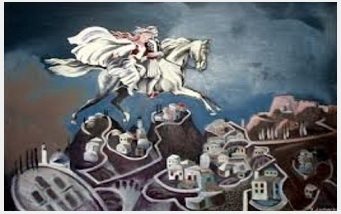The Legend or Doruntinë and Constantin

Doruntine is the only daughter in a family with 13 children including herself. When Doruntine is asked in marriage by a foreign prince, everyone in the family disagrees to let her go so far away. Only Constantin, the youngest of Doruntine's twelve brothers, wants to make her happy and promises his mother that he'll bring Doruntine back to see mother as soon as mother wants to. Eventually mother agrees to the marriage because of Constantin's promise.
At this point all twelve brothers agree to the marriage, but soon they all die in a war, Constantin included. Mother cannot bear the loss of all of her children and not having even her daughter close to her at an old age, her mourning too heavy to bear. Her monologue is full of pathos and anger. During her rage she curses her own dead son, Constantin, who made her a promise he couldn't keep.
At the curse, Constantin wakes up from death and brings Doruntine back, because a mother's curse even after death, is worse than anything else. He finds Doruntine dancing during Easter time. Doruntine knew absolutely nothing about all 12 brothers being dead. Constantin tells her to come immediately with him and brings Doruntine back overnight on the back of his horse. She observes that he looks tired and that he is full of dust, but he tells her that it's because of the long trip. She cannot know that he is already dead. When they arrive back home, he leaves her at the door and tells her that he has to go to Church, but instead goes back to his grave.
Doruntine doesn't realize that she has travelled on his brother's horse when he was already dead, until she is told so by her mother.
The finale is breathtaking because of the shock of the two women who realize that Constantin has risen from the dead.The moral of the legend is that the Albanians will get up from their graves to keep a promises and to maintain their Besa. This is the reason why several times the legend is called Constantin's Besa.
Kadare's version and the theatrical version is far more complicated and involves an investigator, named Stress, of the death who is also the narrator. He analyzes all the possibilities of this strange phenomenon, because no one can accept the rise from the dead. After many interviews with many people, he eventually comes to the conclusion that the Besa can overcome human life and death.
Kadare's thoughts on the legend, which stem from many of his books, are that the legend is pre-Christian, hence the rise from the dead motif.
At this point all twelve brothers agree to the marriage, but soon they all die in a war, Constantin included. Mother cannot bear the loss of all of her children and not having even her daughter close to her at an old age, her mourning too heavy to bear. Her monologue is full of pathos and anger. During her rage she curses her own dead son, Constantin, who made her a promise he couldn't keep.
At the curse, Constantin wakes up from death and brings Doruntine back, because a mother's curse even after death, is worse than anything else. He finds Doruntine dancing during Easter time. Doruntine knew absolutely nothing about all 12 brothers being dead. Constantin tells her to come immediately with him and brings Doruntine back overnight on the back of his horse. She observes that he looks tired and that he is full of dust, but he tells her that it's because of the long trip. She cannot know that he is already dead. When they arrive back home, he leaves her at the door and tells her that he has to go to Church, but instead goes back to his grave.
Doruntine doesn't realize that she has travelled on his brother's horse when he was already dead, until she is told so by her mother.
The finale is breathtaking because of the shock of the two women who realize that Constantin has risen from the dead.The moral of the legend is that the Albanians will get up from their graves to keep a promises and to maintain their Besa. This is the reason why several times the legend is called Constantin's Besa.
Kadare's version and the theatrical version is far more complicated and involves an investigator, named Stress, of the death who is also the narrator. He analyzes all the possibilities of this strange phenomenon, because no one can accept the rise from the dead. After many interviews with many people, he eventually comes to the conclusion that the Besa can overcome human life and death.
Kadare's thoughts on the legend, which stem from many of his books, are that the legend is pre-Christian, hence the rise from the dead motif.
English translation
Robert Elsie has translated into English the ballad from the version of Chameria, from the village of Margëlliç, now in modern Greece, called Kostandini e Dhoqina.[4] The ballad is still sung in the area.[5]
Also see
References
- "Kostandini dhe Doruntina". Retrieved 28 March 2010.
- Doruntine (Paperback) from Ismail Kadare [1] and [2]
- Ismail Kadaré's The Shadow Literature, Dissidence, and Albanian Identity by Peter Morgan, accessdate=28 March 2010 East European Politics & Societies, Vol. 22, No. 2, 402-424 (2008) [3]|
- Elsie, Robert. "The Ballad of Constantine and Dhoqina". Retrieved 3 October 2010.
- Zoto, Vladimir (2006). Balada shqiptare (in Albanian). Dasara. pp. 57–59. ISBN 978-99943-803-2-9.
- Daniel Kelley (October 11, 2008). "Doruntine". nytheatre.com. Retrieved 28 March 2010.
- "Kostandini dhe Doruntina", shfaqja nderballkanike sot ne Tirane". Retrieved 28 March 2010.
- "Besa e vellait te vdekur Doruntina dhe Kostandini rikthejne Margarita Xhepen ne skene". Retrieved 28 March 2010.
